PORCELAIN-CASED CLOCKS – A TASTE OF SPRINGTIME
March 24th 2016
The Georgian age saw a true flowering of clockmaking and clock-design – every type, size and design of clock could be found in London’s clock shops.
One type that began to grow popular from the reign of George III onwards were clocks movements set into porcelain mounts. This is not surprising – just as clocks became an expanding consumer product in Georgian England, so too had porcelain.
Imported Chinese ceramics had been all the rage since at least the mid-17th century, but by the mid-18th century home-grown porcelain factories were flourishing, creating dinner & tea services, vases, figurines and all types of decorative items for the aristocracy and growing middle classes. Clockmakers were always sensitive to changing styles and trends, and it was not long before Chelsea, Derby & Wedgwood were providing specially made porcelain cases and sculptural motifs to allow clockmakers to set off their clock movements.
Benjamin Vulliamy (1747-1811), clockmaker to George III, often combined marble and ormolu with classical figures and putti made in biscuit porcelain to create elegant and fashionable designs in the prevailing Neoclassical fashion. He worked with a variety of porcelain factories, including Derby and Wedgwood, who produced porcelain mounts and figurines to embellish his clocks. A good example is this clock set on a marble pedestal flanked by biscuit porcelain putti – these putti were made by both Wedgwood and Derby, and appear on a number of clocks that Vulliamy produced.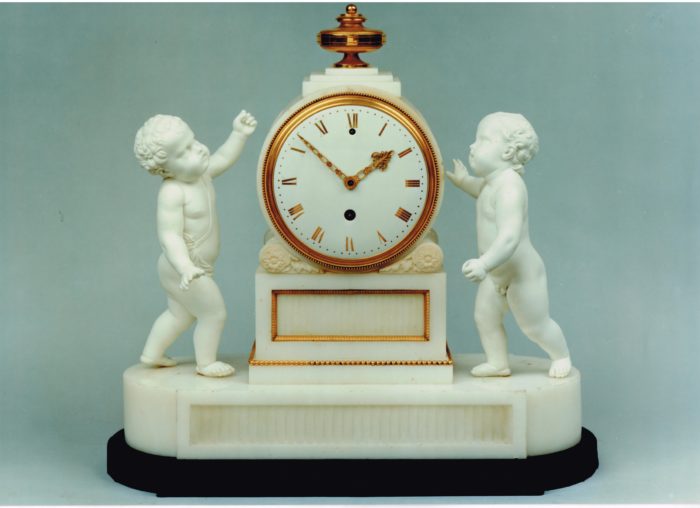 Biscuit porcelain and marble clock by Benjamin Vulliamy. No. 281. Circa 1790. Raffety Ltd.
Biscuit porcelain and marble clock by Benjamin Vulliamy. No. 281. Circa 1790. Raffety Ltd.
Alongside these neoclassical clock designs there was a more flamboyant trend towards colourful porcelain clock cases, decorated with birds, flowers and gilding. The Chelsea porcelain factory produced clock cases in various colours, decorated with birds, foliage and flowers, often with rococo style scrollwork. Sometimes these might incorporate a sunflower motif, with the clock movement at its centre. These designs may have been influenced by similar models being produced on the Continent by firms like the Meissen porcelain factory in Germany.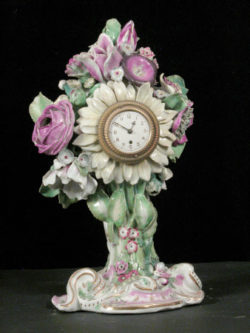
Sunflower and posy shaped clock case. Soft paste porcelain, enamelled and gilt. Chelsea Porcelain Factory, circa 1761. Hanbury Hall. Photo copyright the National Trust.
These floral porcelain clocks proved popular well into the Victoria era. One wonders if these colourful porcelain-cased clocks, with their delicate flowers and birds, remained popular with British consumers as they offered a much-needed reminder of sunshine and springtime flowers against the backdrop of Britain’s often damp and drab weather, and brightened up a room on long, dark winter days?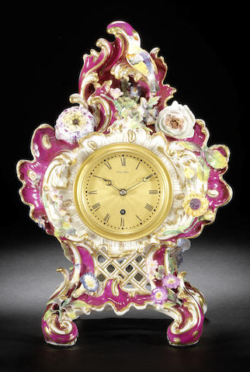
Pink & gilt floral Coalport porcelain clock by Vulliamy, London. Numbered 1186. Raffety Ltd.
Raffety currently has two 19th century examples of these decorative clocks on display at our gallery in Kensington Church Street. The first is by Benjamin Vulliamy’s son and successor as clockmaker to the Crown, Benjamin Lewis Vulliamy (1780-1854). The elaborate porcelain case is by the Coalport factory in Coalbrookdale, Shropshire (established 1795).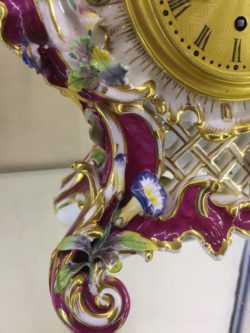
Detail of scrolled foot, with gilding, finely modelled foliage and flowers. Coalport factory. Clock by Vulliamy, London. Raffety Ltd
It follows a typical pattern for these clocks, consisting of Rococo-style scrolled and curving forms, on four scroll feet with open latticework below the dial. Painted pink with gilded detailing, the whole is lavishly embellished with flower heads and foliage, while a small bird is perched on the scrolled pinnacle near the top. Coalport were known for creating floral encrusted porcelain, with highly naturalistic, three-dimensional flowers from the late 1820s onwards, and the style was copied by other factories, including Minton.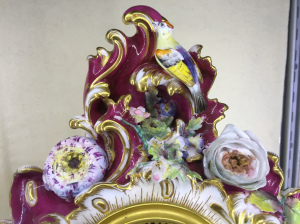
Detail of flowers and bird on the clock by Vulliamy, London. Raffety Ltd.
The single chain fusee movement with anchor escapement has a gilt dial with alternating engine-turned pattern and roman numerals. The clock is numbered 1186 and dates to about 1830. The clock stands 11 inches (28 cm) high. Two similar clocks (by Vulliamy and numbered 1200 and 1409) were supplied to the royal family and are still in the Royal Collection today.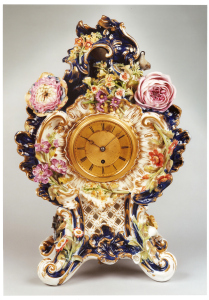
Floral porcelain clock by Adam Thomson, New Bond Street, London. Circa 1840. Raffety Ltd.
A slightly larger example is this one by Adam Thomson (active circa 1830-1860). The case is accented in dark blue with gilt decoration and rococo scrollwork. Like the Vulliamy clock it has four scrolled feet, latticework, and a profusion of roses, daisies, and wildflowers around the dial and sides – a single bird is perched to the right of the scrolling top. It stands 14 inches high (35 cm). The engine-turned dial is signed by the maker “Adam Thomson New Bond Street” and has a fine 8-day single fusee movement. It probably dates to around 1840. The case was probably produced by Coalport or Minton.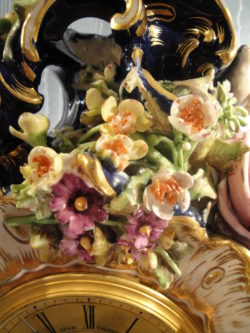
Detail of flowers on the clock by Adam Thomson, London. Raffety Ltd
Adam Thomson made both clocks and watches, and one of his trade cards, giving his address as 25 New Bond Street, survives in the Heal collection in the British Museum. He produced an important book, Time and Time-Keepers, which covered a history of horology, in 1842. He dedicated the book to HRH The Duke of Sussex, probably the first great clock collector.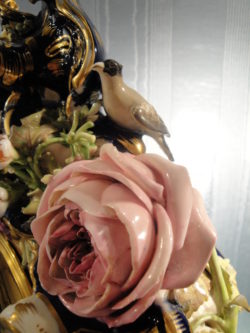
Detail of bird and naturalistic handcrafted and handpainted rose. Coalport or Minton factory. Clock by Adam Thomson, New Bond Street. Raffety Ltd
Porcelain clocks such as these by Vulliamy and Thomson continued to be popular throughout the Victorian period and are still favoured by collectors today. Both these floral clocks offer exquisitely made fusee timepieces, matched with stunning examples of the potter’s art from some of Britain’s finest porcelain factories. If you love both English ceramics and finely made clocks, then these examples are the perfect choice.
The vibrant colours and naturalistic flowers on these clock cases will cheer up any room, reminding us that Spring is on its way.
by Tara Draper-Stumm
Further Reading:
Gordon H. Bushnell, The Illustrated Guide to 19th Century Coalport Coalbrookdale Floral Encrusted Porcelain (2006)
David G. Vulliamy, The Vulliamy Clockmakers (2002)
One type that began to grow popular from the reign of George III onwards were clocks movements set into porcelain mounts. This is not surprising – just as clocks became an expanding consumer product in Georgian England, so too had porcelain.
Imported Chinese ceramics had been all the rage since at least the mid-17th century, but by the mid-18th century home-grown porcelain factories were flourishing, creating dinner & tea services, vases, figurines and all types of decorative items for the aristocracy and growing middle classes. Clockmakers were always sensitive to changing styles and trends, and it was not long before Chelsea, Derby & Wedgwood were providing specially made porcelain cases and sculptural motifs to allow clockmakers to set off their clock movements.
Benjamin Vulliamy (1747-1811), clockmaker to George III, often combined marble and ormolu with classical figures and putti made in biscuit porcelain to create elegant and fashionable designs in the prevailing Neoclassical fashion. He worked with a variety of porcelain factories, including Derby and Wedgwood, who produced porcelain mounts and figurines to embellish his clocks. A good example is this clock set on a marble pedestal flanked by biscuit porcelain putti – these putti were made by both Wedgwood and Derby, and appear on a number of clocks that Vulliamy produced.
 Biscuit porcelain and marble clock by Benjamin Vulliamy. No. 281. Circa 1790. Raffety Ltd.
Biscuit porcelain and marble clock by Benjamin Vulliamy. No. 281. Circa 1790. Raffety Ltd.Alongside these neoclassical clock designs there was a more flamboyant trend towards colourful porcelain clock cases, decorated with birds, flowers and gilding. The Chelsea porcelain factory produced clock cases in various colours, decorated with birds, foliage and flowers, often with rococo style scrollwork. Sometimes these might incorporate a sunflower motif, with the clock movement at its centre. These designs may have been influenced by similar models being produced on the Continent by firms like the Meissen porcelain factory in Germany.

Sunflower and posy shaped clock case. Soft paste porcelain, enamelled and gilt. Chelsea Porcelain Factory, circa 1761. Hanbury Hall. Photo copyright the National Trust.
These floral porcelain clocks proved popular well into the Victoria era. One wonders if these colourful porcelain-cased clocks, with their delicate flowers and birds, remained popular with British consumers as they offered a much-needed reminder of sunshine and springtime flowers against the backdrop of Britain’s often damp and drab weather, and brightened up a room on long, dark winter days?

Pink & gilt floral Coalport porcelain clock by Vulliamy, London. Numbered 1186. Raffety Ltd.
Raffety currently has two 19th century examples of these decorative clocks on display at our gallery in Kensington Church Street. The first is by Benjamin Vulliamy’s son and successor as clockmaker to the Crown, Benjamin Lewis Vulliamy (1780-1854). The elaborate porcelain case is by the Coalport factory in Coalbrookdale, Shropshire (established 1795).

Detail of scrolled foot, with gilding, finely modelled foliage and flowers. Coalport factory. Clock by Vulliamy, London. Raffety Ltd
It follows a typical pattern for these clocks, consisting of Rococo-style scrolled and curving forms, on four scroll feet with open latticework below the dial. Painted pink with gilded detailing, the whole is lavishly embellished with flower heads and foliage, while a small bird is perched on the scrolled pinnacle near the top. Coalport were known for creating floral encrusted porcelain, with highly naturalistic, three-dimensional flowers from the late 1820s onwards, and the style was copied by other factories, including Minton.

Detail of flowers and bird on the clock by Vulliamy, London. Raffety Ltd.
The single chain fusee movement with anchor escapement has a gilt dial with alternating engine-turned pattern and roman numerals. The clock is numbered 1186 and dates to about 1830. The clock stands 11 inches (28 cm) high. Two similar clocks (by Vulliamy and numbered 1200 and 1409) were supplied to the royal family and are still in the Royal Collection today.

Floral porcelain clock by Adam Thomson, New Bond Street, London. Circa 1840. Raffety Ltd.
A slightly larger example is this one by Adam Thomson (active circa 1830-1860). The case is accented in dark blue with gilt decoration and rococo scrollwork. Like the Vulliamy clock it has four scrolled feet, latticework, and a profusion of roses, daisies, and wildflowers around the dial and sides – a single bird is perched to the right of the scrolling top. It stands 14 inches high (35 cm). The engine-turned dial is signed by the maker “Adam Thomson New Bond Street” and has a fine 8-day single fusee movement. It probably dates to around 1840. The case was probably produced by Coalport or Minton.

Detail of flowers on the clock by Adam Thomson, London. Raffety Ltd
Adam Thomson made both clocks and watches, and one of his trade cards, giving his address as 25 New Bond Street, survives in the Heal collection in the British Museum. He produced an important book, Time and Time-Keepers, which covered a history of horology, in 1842. He dedicated the book to HRH The Duke of Sussex, probably the first great clock collector.

Detail of bird and naturalistic handcrafted and handpainted rose. Coalport or Minton factory. Clock by Adam Thomson, New Bond Street. Raffety Ltd
Porcelain clocks such as these by Vulliamy and Thomson continued to be popular throughout the Victorian period and are still favoured by collectors today. Both these floral clocks offer exquisitely made fusee timepieces, matched with stunning examples of the potter’s art from some of Britain’s finest porcelain factories. If you love both English ceramics and finely made clocks, then these examples are the perfect choice.
The vibrant colours and naturalistic flowers on these clock cases will cheer up any room, reminding us that Spring is on its way.
by Tara Draper-Stumm
Further Reading:
Gordon H. Bushnell, The Illustrated Guide to 19th Century Coalport Coalbrookdale Floral Encrusted Porcelain (2006)
David G. Vulliamy, The Vulliamy Clockmakers (2002)

